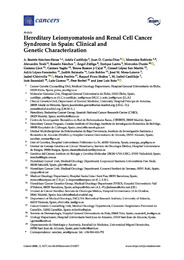Please use this identifier to cite or link to this item:
https://hdl.handle.net/11000/35316Full metadata record
| DC Field | Value | Language |
|---|---|---|
| dc.contributor.author | Sánchez-Heras, Beatriz A. | - |
| dc.contributor.author | Castillejo, Adela | - |
| dc.contributor.author | García Díaz, Juan de Dios | - |
| dc.contributor.author | Robledo, Mercedes | - |
| dc.contributor.author | Teulé, Alexandre | - |
| dc.contributor.author | Sánchez, Rosario | - |
| dc.contributor.author | Zúñiga, Ángel | - |
| dc.contributor.author | Lastra, Enrique | - |
| dc.contributor.author | Durán, Mereces | - |
| dc.contributor.author | Llort, Gemma | - |
| dc.contributor.author | Yagüe, Carmen | - |
| dc.contributor.author | Ramón y Cajal, Teresa | - |
| dc.contributor.author | López San Martín, Consol | - |
| dc.contributor.author | GÓMEZ FERNÁNDEZ, ADRIÁ | - |
| dc.contributor.other | Departamentos de la UMH::Patología y Cirugía | es_ES |
| dc.date.accessioned | 2025-01-26T10:43:45Z | - |
| dc.date.available | 2025-01-26T10:43:45Z | - |
| dc.date.created | 2020-11-05 | - |
| dc.identifier.citation | Cancers (Basel) . 2020 Nov 5;12(11):3277. | es_ES |
| dc.identifier.issn | 2072-6694 | - |
| dc.identifier.uri | https://hdl.handle.net/11000/35316 | - |
| dc.description.abstract | Hereditary leiomyomatosis and renal cell cancer syndrome (HLRCC) is a very rare hereditary disorder characterized by cutaneous leiomyomas (CLMs), uterine leiomyomas (ULMs), renal cysts (RCys) and renal cell cancers (RCCs). We aimed to describe the genetics, clinical features and potential genotype-phenotype associations in the largest cohort of fumarate hydratase enzyme mutation carriers known from Spain using a multicentre, retrospective study of individuals with a genetic or clinical diagnosis of HLRCC. We collected clinical information from medical records, analysed genetic variants and looked for genotype-phenotype associations. Analyses were performed using R 3.6.0. software. We included 197 individuals: 74 index cases and 123 relatives. CLMs were diagnosed in 65% of patients, ULMs in 90% of women, RCys in 37% and RCC in 10.9%. Twenty-seven different pathogenic variants were detected, 12 (44%) of them not reported previously. Patients with missense pathogenic variants showed higher frequencies of CLMs, ULMs and RCys, than those with loss-of-function variants (p = 0.0380, p = 0.0015 and p = 0.024, respectively). This is the first report of patients with HLRCC from Spain. The frequency of RCCs was lower than those reported in the previously published series. Individuals with missense pathogenic variants had higher frequencies of CLMs, ULMs and RCys. | es_ES |
| dc.format | application/pdf | es_ES |
| dc.format.extent | 16 | es_ES |
| dc.language.iso | eng | es_ES |
| dc.publisher | MDPI | es_ES |
| dc.rights | info:eu-repo/semantics/openAccess | es_ES |
| dc.subject | FH gene | es_ES |
| dc.subject | hereditary leiomyomatosis | es_ES |
| dc.subject | leiomyomas | es_ES |
| dc.subject | missense pathogenic variants | es_ES |
| dc.subject | renal cell cancer | es_ES |
| dc.title | Hereditary Leiomyomatosis and Renal Cell Cancer Syndrome in Spain: Clinical and Genetic Characterization | es_ES |
| dc.type | info:eu-repo/semantics/article | es_ES |
| dc.relation.publisherversion | 10.3390/cancers12113277 | es_ES |

View/Open:
2020 Hereditary leiomyomatosis....pdf
25,31 MB
Adobe PDF
Share:
Items in DSpace are protected by copyright, with all rights reserved, unless otherwise indicated.
.png)